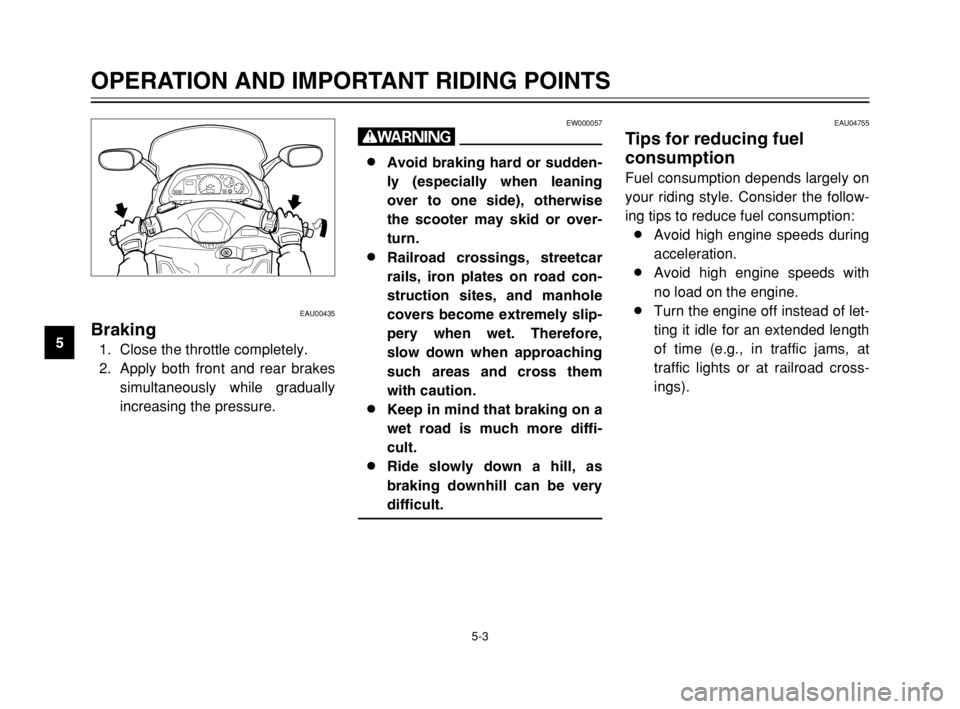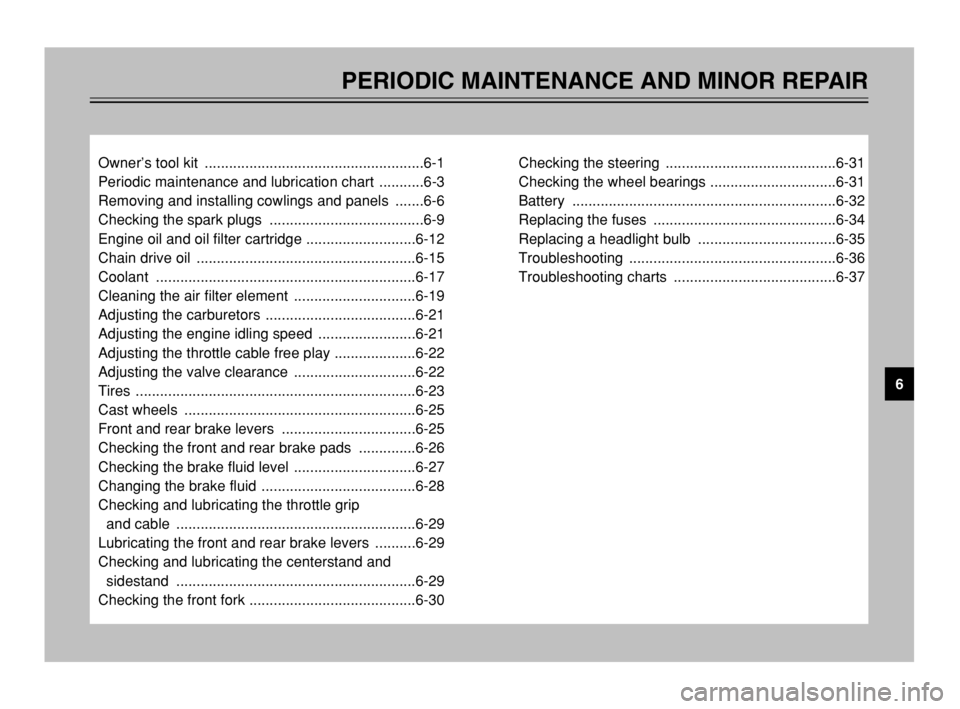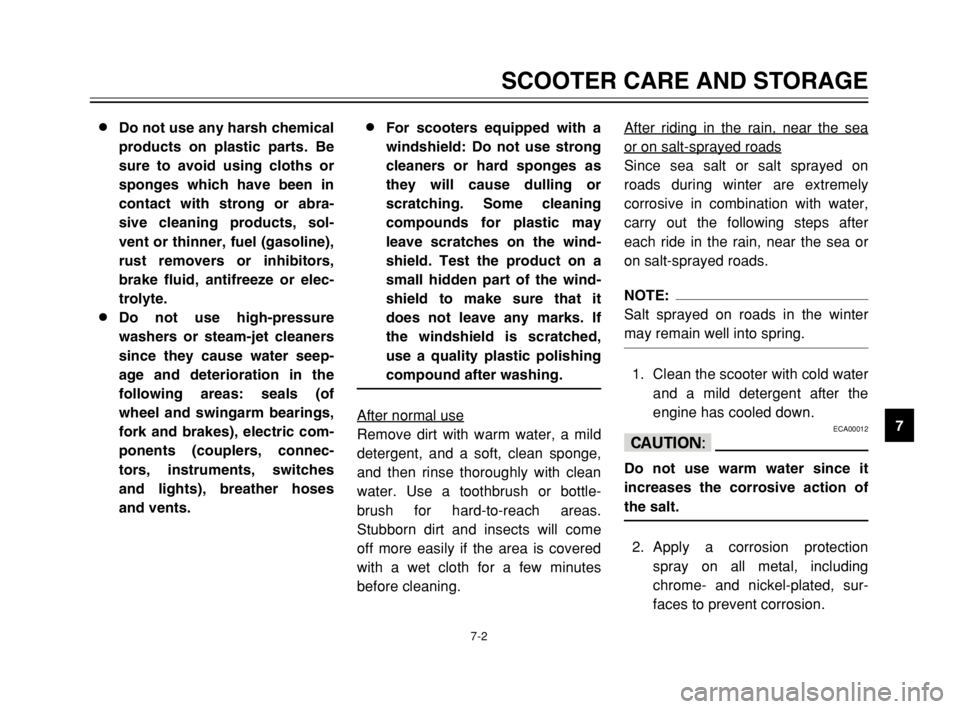brake light YAMAHA TMAX 2003 Owners Manual
[x] Cancel search | Manufacturer: YAMAHA, Model Year: 2003, Model line: TMAX, Model: YAMAHA TMAX 2003Pages: 104, PDF Size: 1.67 MB
Page 17 of 104

INSTRUMENT AND CONTROL FUNCTIONS
Main switch/steering lock ...................................................................3-1
Indicator lights ...................................................................................3-2
Speedometer unit ..............................................................................3-4
Fuel gauge .........................................................................................3-4
Coolant temperature gauge ...............................................................3-5
Clock ..................................................................................................3-5
Self-diagnosis device .........................................................................3-6
Anti-theft alarm (optional) ..................................................................3-6
Handlebar switches ...........................................................................3-6
Front brake lever ...............................................................................3-9
Rear brake lever ................................................................................3-9
Fuel tank cap .....................................................................................3-9
Fuel ..................................................................................................3-10
Seat .................................................................................................3-11
Adjusting the rider backrest .............................................................3-12
Shock absorber ...............................................................................3-13
Helmet holder ..................................................................................3-13
Storage compartments ....................................................................3-14
Sidestand .........................................................................................3-14
Ignition circuit cut-off system ...........................................................3-15
3
5GJ-28199-E2 9/9/02 9:15 AM Page 15
Page 24 of 104

3-7
EAU03889
Turn signal switch “4/6”Turn signal switch
To signal a right-hand turn, push this
switch to “6”. To signal a left-hand
turn, push this switch to “4”. When
released, the switch returns to the
center position. To cancel the turn
signal lights, push the switch in after
it has returned to the center position.
EAU00129
Horn switch “*”Horn switch
Press this switch to sound the horn.
INSTRUMENT AND CONTROL FUNCTIONS
3
1
2
3
4
1. Pass switch “PASS”
2. Dimmer switch “&/%”
3. Turn signal switch “4/6”
4. Horn switch “*”
EAU03890
Engine stop switch “#/$”Engine stop switch
Set this switch to “#” before starting
the engine. Set this switch to “$” to
stop the engine in case of an emer-
gency, such as when the scooter
overturns or when the throttle cable is
stuck.
1
2
3
1. Engine stop switch “#/$”
2. Hazard switch “0”
3. Start switch “,”
EAU03826
Hazard switch “0”Hazard switch
With the key in the “ON” or “.” posi-
tion, use this switch to turn on the
hazard light (simultaneous flashing of
all turn signal lights).
The hazard light is used in case of an
emergency or to warn other drivers
when your scooter is stopped where
it might be a traffic hazard.
EC000006
cC
Do not use the hazard light for an
extended length of time, otherwise
the battery may discharge.
EAU03801
Start switch “,”Start switch
With the sidestand up, push this
switch while applying the front or rear
brake to crank the engine with the
starter.
EC000005
cC
See page 5-1 for starting instruc-
tions prior to starting the engine.
5GJ-28199-E2 9/9/02 9:15 AM Page 22
Page 32 of 104

3-15
EW000044
w
The scooter must not be ridden
with the sidestand down, or if the
sidestand cannot be properly
moved up (or does not stay up),
otherwise the sidestand could con-
tact the ground and distract the
operator, resulting in a possible
loss of control. Yamaha’s ignition
circuit cut-off system has been
designed to assist the operator in
fulfilling the responsibility of rais-
ing the sidestand before starting
off. Therefore, check this system
regularly as described below and
have a Yamaha dealer repair it if it
does not function properly.
INSTRUMENT AND CONTROL FUNCTIONS
3
EAU00337
Ignition circuit cut-off
system
Ignition circuit cut-off system
The ignition circuit cut-off system
(comprising the sidestand switch and
brake light switches) has the follow-
ing functions.
8It prevents starting when the
sidestand is up, but neither brake
is applied.
8It prevents starting when either
brake is applied, but the side-
stand is still down.
8It cuts the running engine when
the sidestand is moved down.
Periodically check the operation of
the ignition circuit cut-off system
according to the following procedure.
EW000045
w
If a malfunction is noted, have a
Yamaha dealer check the system
before riding.
5GJ-28199-E2 9/9/02 9:15 AM Page 30
Page 37 of 104

4-2
PRE-OPERATION CHECKS
4
NOTE:
Pre-operation checks should be made each time the scooter is used. Such an inspection can be accomplished in a very
short time; and the added safety it assures is more than worth the time involved.
EWA00033
w
If any item in the Pre-operation check list is not working properly, have it inspected and repaired before operat-
ing the scooter.
Throttle grip•Make sure that operation is smooth.
•Check cable free play.
•If necessary, have Yamaha dealer adjust cable free play and lubricate cable and
grip housing.6-22, 6-29
Wheels and tires•Check for damage.
•Check tire condition and tread depth.
•Check air pressure.
•Correct if necessary.6-23–6-25
Brake levers•Make sure that operation is smooth.
•Lubricate lever pivoting points if necessary.3-9, 6-29
Centerstand, sidestand•Make sure that operation is smooth.
•Lubricate pivots if necessary.6-29–6-30
Chassis fasteners•Make sure that all nuts, bolts and screws are properly tightened.
•Tighten if necessary.—
Instruments, lights, signals
and switches•Check operation.
•Correct if necessary.3-2–3-8, 6-35–6-36
Sidestand switch•Check operation of ignition circuit cut-off system.
•If system is defective, have Yamaha dealer check vehicle.3-14–3-16 ITEM CHECKS PAGE
5GJ-28199-E2 9/9/02 9:15 AM Page 35
Page 42 of 104

5-3
OPERATION AND IMPORTANT RIDING POINTS
5
EAU00435
BrakingBraking
1. Close the throttle completely.
2. Apply both front and rear brakes
simultaneously while gradually
increasing the pressure.
EW000057
w
8 8
Avoid braking hard or sudden-
ly (especially when leaning
over to one side), otherwise
the scooter may skid or over-
turn.
8 8
Railroad crossings, streetcar
rails, iron plates on road con-
struction sites, and manhole
covers become extremely slip-
pery when wet. Therefore,
slow down when approaching
such areas and cross them
with caution.
8 8
Keep in mind that braking on a
wet road is much more diffi-
cult.
8 8
Ride slowly down a hill, as
braking downhill can be very
difficult.
EAU04755
Tips for reducing fuel
consumption
Fuel consumption, tips for reducing
Fuel consumption depends largely on
your riding style. Consider the follow-
ing tips to reduce fuel consumption:
8Avoid high engine speeds during
acceleration.
8Avoid high engine speeds with
no load on the engine.
8Turn the engine off instead of let-
ting it idle for an extended length
of time (e.g., in traffic jams, at
traffic lights or at railroad cross-
ings).
5GJ-28199-E2 9/9/02 9:15 AM Page 40
Page 45 of 104

PERIODIC MAINTENANCE AND MINOR REPAIR
Owner’s tool kit ......................................................6-1
Periodic maintenance and lubrication chart ...........6-3
Removing and installing cowlings and panels .......6-6
Checking the spark plugs ......................................6-9
Engine oil and oil filter cartridge ...........................6-12
Chain drive oil ......................................................6-15
Coolant ................................................................6-17
Cleaning the air filter element ..............................6-19
Adjusting the carburetors .....................................6-21
Adjusting the engine idling speed ........................6-21
Adjusting the throttle cable free play ....................6-22
Adjusting the valve clearance ..............................6-22
Tires .....................................................................6-23
Cast wheels .........................................................6-25
Front and rear brake levers .................................6-25
Checking the front and rear brake pads ..............6-26
Checking the brake fluid level ..............................6-27
Changing the brake fluid ......................................6-28
Checking and lubricating the throttle grip
and cable ...........................................................6-29
Lubricating the front and rear brake levers ..........6-29
Checking and lubricating the centerstand and
sidestand ...........................................................6-29
Checking the front fork .........................................6-30Checking the steering ..........................................6-31
Checking the wheel bearings ...............................6-31
Battery .................................................................6-32
Replacing the fuses .............................................6-34
Replacing a headlight bulb ..................................6-35
Troubleshooting ...................................................6-36
Troubleshooting charts ........................................6-37
6
5GJ-28199-E2 9/9/02 9:15 AM Page 43
Page 50 of 104

6-5
PERIODIC MAINTENANCE AND MINOR REPAIR
6
EAU03884
NOTE:
8The air filter needs more frequent service if you are riding in unusually wet or dusty areas.
8Hydraulic brake service
9Regularly check and, if necessary, correct the brake fluid level.
9Every two years replace the internal components of the brake master cylinders and calipers, and change the
brake fluid.
9Replace the brake hoses every four years and if cracked or damaged.
20 Engine oil•Change. (See page 3-2 and 6-15 for more information
about the oil change indicator light.)√4,000 km after initial 1,000 km
When the oil change indicator light comes on
(every 5,000 km)
•Check oil level and vehicle for oil leakage.Every 5,000 km√
21 Engine oil filter cartridge•Replace.√√√
22
*Cooling system•Check coolant level and vehicle for coolant leakage.√√√√ √
•Change.Every 3 years
23 Chain drive oil•Check vehicle for oil leakage.
•Change.√√√√
24
*V-belt•Replace.When the V-belt replacement indicator light comes on
(every 20,000 km)
25
*Front and rear brake
switches•Check operation.√√√√√ √
26 Moving parts and cables•Lubricate.√√√√ √
27
*Lights, signals and
switches•Check operation.
•Adjust headlight beam.√√√√√ √ NO. ITEM CHECK OR MAINTENANCE JOBODOMETER READING (× 1,000 km)
ANNUAL
CHECK
1 10203040
5GJ-28199-E2 9/9/02 9:15 AM Page 48
Page 87 of 104

7-2
SCOOTER CARE AND STORAGE
7 8 8
Do not use any harsh chemical
products on plastic parts. Be
sure to avoid using cloths or
sponges which have been in
contact with strong or abra-
sive cleaning products, sol-
vent or thinner, fuel (gasoline),
rust removers or inhibitors,
brake fluid, antifreeze or elec-
trolyte.
8 8
Do not use high-pressure
washers or steam-jet cleaners
since they cause water seep-
age and deterioration in the
following areas: seals (of
wheel and swingarm bearings,
fork and brakes), electric com-
ponents (couplers, connec-
tors, instruments, switches
and lights), breather hoses
and vents.8 8
For scooters equipped with a
windshield: Do not use strong
cleaners or hard sponges as
they will cause dulling or
scratching. Some cleaning
compounds for plastic may
leave scratches on the wind-
shield. Test the product on a
small hidden part of the wind-
shield to make sure that it
does not leave any marks. If
the windshield is scratched,
use a quality plastic polishing
compound after washing.After normal use
Remove dirt with warm water, a mild
detergent, and a soft, clean sponge,
and then rinse thoroughly with clean
water. Use a toothbrush or bottle-
brush for hard-to-reach areas.
Stubborn dirt and insects will come
off more easily if the area is covered
with a wet cloth for a few minutes
before cleaning.After riding in the rain, near the sea
or on salt-sprayed roads
Since sea salt or salt sprayed on
roads during winter are extremely
corrosive in combination with water,
carry out the following steps after
each ride in the rain, near the sea or
on salt-sprayed roads.
NOTE:
Salt sprayed on roads in the winter
may remain well into spring.
1. Clean the scooter with cold water
and a mild detergent after the
engine has cooled down.
ECA00012
cC
Do not use warm water since it
increases the corrosive action of
the salt.
2. Apply a corrosion protection
spray on all metal, including
chrome- and nickel-plated, sur-
faces to prevent corrosion.
5GJ-28199-E2 9/9/02 9:15 AM Page 85
Page 94 of 104

8-3
SPECIFICATIONS
8
Wheels
Front
Type Cast wheel
Size 14 M/C ×MT3.50
Rear
Type Cast wheel
Size 14 M/C ×MT4.50
Brakes
Front
Type Single disc brake
Operation Right hand
Fluid DOT 4
Rear
Type Single disc brake
Operation Left hand
Fluid DOT 4Suspension
Front Telescopic fork
Rear Swingarm
Spring/shock absorbers
Front Coil spring/oil damper
Rear Coil spring/gas-oil damper
Wheel travel
Front 120 mm
Rear 120 mm
Electrical
Ignition system Transistorized coil ignition
(digital)
Charging system
Type A.C. magneto
Standard output 14 V, 310W @ 5,000 r/min
Battery
Type GT9B-4
Voltage, capacity 12 V, 8 Ah
Headlight bulb typeHalogen
Bulb voltage, wattage ×quantity
Headlight 12 V, 60/55 W ×1
12 V, 55 W ×1
5GJ-28199-E2 9/9/02 9:15 AM Page 92
Page 95 of 104

8-4
SPECIFICATIONS
8
Tail/brake light 12 V, 5/21 W ×2
Front turn signal light 12 V, 5/21 W ×2
Rear turn signal light 12 V, 21 W ×2
Auxiliary light 12 V, 5 W ×2
License plate light 12 V, 5 W ×1
Meter lighting 12 V, 1.7 W ×3
High beam indicator light 12 V, 1.7 W ×1
Oil change indicator light 12 V, 1.7 W ×1
Turn indicator light 12 V, 3.4 W ×2
V-belt replacement
indicator light 12 V, 1.7 W ×1
Fuses
Main fuse 30 A
Signaling system fuse 15 A
Headlight fuse 15 A
Ignition fuse 10 A
Radiator fan fuse 15 A
Hazard fuse 10 A
Clock fuse (backup fuse) 10 A
5GJ-28199-E2 9/9/02 9:15 AM Page 93